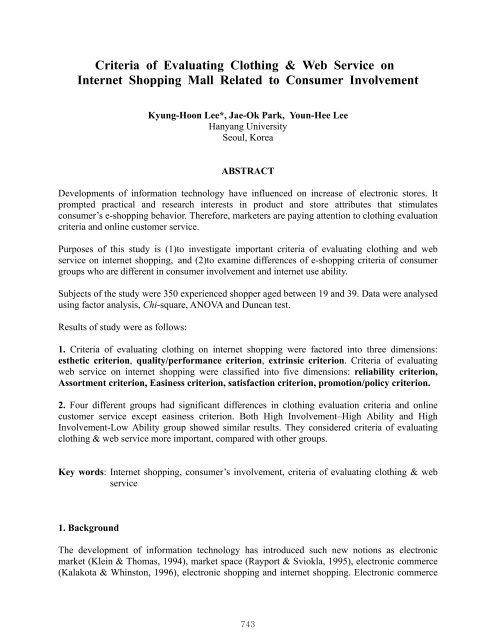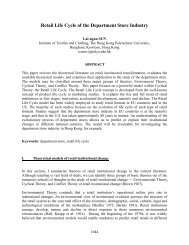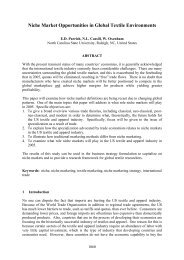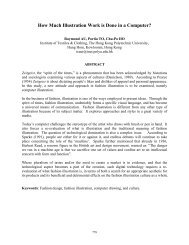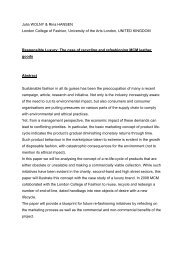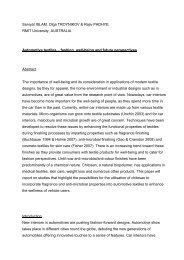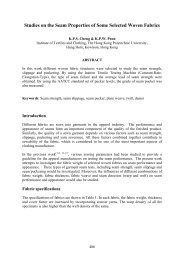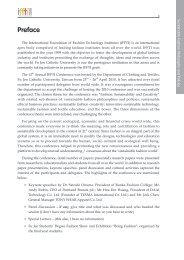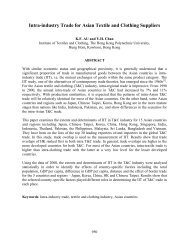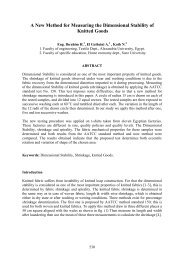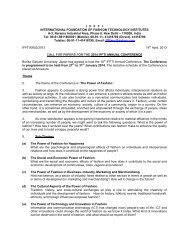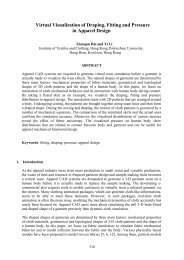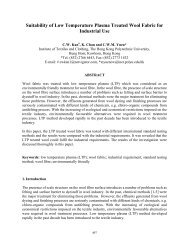Criteria of Evaluating Clothing & Web Service on Internet Shopping ...
Criteria of Evaluating Clothing & Web Service on Internet Shopping ...
Criteria of Evaluating Clothing & Web Service on Internet Shopping ...
You also want an ePaper? Increase the reach of your titles
YUMPU automatically turns print PDFs into web optimized ePapers that Google loves.
<str<strong>on</strong>g>Criteria</str<strong>on</strong>g> <str<strong>on</strong>g>of</str<strong>on</strong>g> <str<strong>on</strong>g>Evaluating</str<strong>on</strong>g> <str<strong>on</strong>g>Clothing</str<strong>on</strong>g> & <str<strong>on</strong>g>Web</str<strong>on</strong>g> <str<strong>on</strong>g>Service</str<strong>on</strong>g> <strong>on</strong><br />
<strong>Internet</strong> <strong>Shopping</strong> Mall Related to C<strong>on</strong>sumer Involvement<br />
Kyung-Ho<strong>on</strong> Lee*, Jae-Ok Park, Youn-Hee Lee<br />
Hanyang University<br />
Seoul, Korea<br />
ABSTRACT<br />
Developments <str<strong>on</strong>g>of</str<strong>on</strong>g> informati<strong>on</strong> technology have influenced <strong>on</strong> increase <str<strong>on</strong>g>of</str<strong>on</strong>g> electr<strong>on</strong>ic stores. It<br />
prompted practical and research interests in product and store attributes that stimulates<br />
c<strong>on</strong>sumer’s e-shopping behavior. Therefore, marketers are paying attenti<strong>on</strong> to clothing evaluati<strong>on</strong><br />
criteria and <strong>on</strong>line customer service.<br />
Purposes <str<strong>on</strong>g>of</str<strong>on</strong>g> this study is (1)to investigate important criteria <str<strong>on</strong>g>of</str<strong>on</strong>g> evaluating clothing and web<br />
service <strong>on</strong> internet shopping, and (2)to examine differences <str<strong>on</strong>g>of</str<strong>on</strong>g> e-shopping criteria <str<strong>on</strong>g>of</str<strong>on</strong>g> c<strong>on</strong>sumer<br />
groups who are different in c<strong>on</strong>sumer involvement and internet use ability.<br />
Subjects <str<strong>on</strong>g>of</str<strong>on</strong>g> the study were 350 experienced shopper aged between 19 and 39. Data were analysed<br />
using factor analysis, Chi-square, ANOVA and Duncan test.<br />
Results <str<strong>on</strong>g>of</str<strong>on</strong>g> study were as follows:<br />
1. <str<strong>on</strong>g>Criteria</str<strong>on</strong>g> <str<strong>on</strong>g>of</str<strong>on</strong>g> evaluating clothing <strong>on</strong> internet shopping were factored into three dimensi<strong>on</strong>s:<br />
esthetic criteri<strong>on</strong>, quality/performance criteri<strong>on</strong>, extrinsic criteri<strong>on</strong>. <str<strong>on</strong>g>Criteria</str<strong>on</strong>g> <str<strong>on</strong>g>of</str<strong>on</strong>g> evaluating<br />
web service <strong>on</strong> internet shopping were classified into five dimensi<strong>on</strong>s: reliability criteri<strong>on</strong>,<br />
Assortment criteri<strong>on</strong>, Easiness criteri<strong>on</strong>, satisfacti<strong>on</strong> criteri<strong>on</strong>, promoti<strong>on</strong>/policy criteri<strong>on</strong>.<br />
2. Four different groups had significant differences in clothing evaluati<strong>on</strong> criteria and <strong>on</strong>line<br />
customer service except easiness criteri<strong>on</strong>. Both High Involvement–High Ability and High<br />
Involvement-Low Ability group showed similar results. They c<strong>on</strong>sidered criteria <str<strong>on</strong>g>of</str<strong>on</strong>g> evaluating<br />
clothing & web service more important, compared with other groups.<br />
Key words: <strong>Internet</strong> shopping, c<strong>on</strong>sumer’s involvement, criteria <str<strong>on</strong>g>of</str<strong>on</strong>g> evaluating clothing & web<br />
service<br />
1. Background<br />
The development <str<strong>on</strong>g>of</str<strong>on</strong>g> informati<strong>on</strong> technology has introduced such new noti<strong>on</strong>s as electr<strong>on</strong>ic<br />
market (Klein & Thomas, 1994), market space (Rayport & Sviokla, 1995), electr<strong>on</strong>ic commerce<br />
(Kalakota & Whinst<strong>on</strong>, 1996), electr<strong>on</strong>ic shopping and internet shopping. Electr<strong>on</strong>ic commerce<br />
743
is defined as “business transacti<strong>on</strong>s <str<strong>on</strong>g>of</str<strong>on</strong>g> internet <strong>on</strong>-line system, as well as traditi<strong>on</strong>al business<br />
deals through automatic technology.” (Kalakota & Whinst<strong>on</strong>, 1997)<br />
The Nati<strong>on</strong>al Statistical Office reported that the number <str<strong>on</strong>g>of</str<strong>on</strong>g> cyber shopping malls in Korea was<br />
2,072 in September, increasing 40 more compared with that in August, according to the census <str<strong>on</strong>g>of</str<strong>on</strong>g><br />
<strong>on</strong>-internet domestic market scale in the third quarter <str<strong>on</strong>g>of</str<strong>on</strong>g> 2001. The total sales in September<br />
increased 9.6% compared with that in August. The share <str<strong>on</strong>g>of</str<strong>on</strong>g> business to c<strong>on</strong>sumer has also<br />
increased 67.8 billi<strong>on</strong> w<strong>on</strong> since the census in the sec<strong>on</strong>d quarter <str<strong>on</strong>g>of</str<strong>on</strong>g> 2001. From according to<br />
Korea <strong>Internet</strong> Informati<strong>on</strong> Center, the domestic internet-using populati<strong>on</strong> reached 24.12 milli<strong>on</strong><br />
in September that 22.23 milli<strong>on</strong> in July. These statistics showed that there were 1.89 milli<strong>on</strong> more<br />
users within 3 m<strong>on</strong>ths.<br />
The number <str<strong>on</strong>g>of</str<strong>on</strong>g> internet shopping malls and internet-using populati<strong>on</strong> shows five-time increase<br />
every year are expected to grow more rapidly. Therefore, the research for c<strong>on</strong>sumer<br />
characteristics <strong>on</strong> internet shopping is needed to facilitate better internet shopping mall.<br />
Meanwhile, c<strong>on</strong>sumer behavior model <str<strong>on</strong>g>of</str<strong>on</strong>g> EKB can explain that the degree <str<strong>on</strong>g>of</str<strong>on</strong>g> c<strong>on</strong>sumer<br />
involvement make the difference in informati<strong>on</strong> searching and alternative evaluati<strong>on</strong> processing,<br />
because <str<strong>on</strong>g>of</str<strong>on</strong>g> different learning process (Assael, 1987; Kassarjian 1981; Roberts<strong>on</strong> 1976). That is to<br />
say, purchase behavior shows various patterns according to the level <str<strong>on</strong>g>of</str<strong>on</strong>g> their involvement and the<br />
level will decide the evaluati<strong>on</strong> basis <strong>on</strong> the products and shops they choose. Therefore, the<br />
research for criteria <str<strong>on</strong>g>of</str<strong>on</strong>g> evaluating clothing and web service <strong>on</strong> internet shopping mall will help<br />
marketers understand c<strong>on</strong>sumer <strong>on</strong> the new distributi<strong>on</strong> circumstances, and cope with their<br />
behavior. It can help clothing manufacturers to set market strategies <str<strong>on</strong>g>of</str<strong>on</strong>g> selling products more<br />
efficiently <strong>on</strong> the internet shopping malls the new cyber space.<br />
2. Methods<br />
(1) Research Purpose<br />
(1)to investigate important criteria <str<strong>on</strong>g>of</str<strong>on</strong>g> evaluating clothing and web service <strong>on</strong> internet shopping,<br />
(2)to examine differences <str<strong>on</strong>g>of</str<strong>on</strong>g> e-shopping criteria <str<strong>on</strong>g>of</str<strong>on</strong>g> c<strong>on</strong>sumer groups who are different in<br />
c<strong>on</strong>sumer involvement and internet use ability.<br />
(2) Sample and Data Collecti<strong>on</strong> Procedure<br />
The subjects <str<strong>on</strong>g>of</str<strong>on</strong>g> this study were 350 experienced shopper aged between 19 and 39, living in Seoul<br />
and Gye<strong>on</strong>ggi-do area. The judgment samping method was used by c<strong>on</strong>tacting instructors <str<strong>on</strong>g>of</str<strong>on</strong>g><br />
classes to distribute the questi<strong>on</strong>naire.<br />
The questi<strong>on</strong>naire c<strong>on</strong>sisted <str<strong>on</strong>g>of</str<strong>on</strong>g> the questi<strong>on</strong>s about c<strong>on</strong>sumer involvement, internet use ability,<br />
criteria <str<strong>on</strong>g>of</str<strong>on</strong>g> evaluating clothing and web service <strong>on</strong> internet shopping. The criteria <str<strong>on</strong>g>of</str<strong>on</strong>g> c<strong>on</strong>sumer<br />
involvement were derived from prior studies (i.e., Bloch, 1982; Kapferer & Laurent, 1985; Sunhe<br />
Kim, 1999; Hyo-shin Kim, 2000). The questi<strong>on</strong>s item about internet use ability were derived<br />
from Hyo-shin Kim (2000)’s study. The questi<strong>on</strong>s item about the criteria <str<strong>on</strong>g>of</str<strong>on</strong>g> evaluating clothing<br />
were adapted from the <strong>on</strong>ly part that is related to internet shopping <str<strong>on</strong>g>of</str<strong>on</strong>g> prior studies (i.e., Eckman,<br />
Damhorst & Kadolph, 1990; Mi-young Kim, 1988) <str<strong>on</strong>g>of</str<strong>on</strong>g> clothing evaluati<strong>on</strong> criteria, esthetic<br />
744
criteri<strong>on</strong>, quality/performance criteri<strong>on</strong>, and extrinsic criteri<strong>on</strong>, three factors were employed. The<br />
criteria <str<strong>on</strong>g>of</str<strong>on</strong>g> evaluati<strong>on</strong> web service were adapted from previous literatures (i.e., Lohse & Spiller,<br />
1998; Hyo-shin Kim, 2000; Hark-jin No, 1999) <str<strong>on</strong>g>of</str<strong>on</strong>g> <strong>on</strong>line customer service criteria, reliability<br />
criteri<strong>on</strong>, assortment criteri<strong>on</strong>, easiness criteri<strong>on</strong>, satisfacti<strong>on</strong> criteri<strong>on</strong>, and promoti<strong>on</strong>/policy<br />
criteri<strong>on</strong>, five factors were employed. Five-point Likerts scaling was used and reliability<br />
measures (Cr<strong>on</strong>bach's Alpha) were all over .5.<br />
The data collecti<strong>on</strong> began November 1 and ended <strong>on</strong> November 12, 2001. A total <str<strong>on</strong>g>of</str<strong>on</strong>g> 350<br />
questi<strong>on</strong>naires were returned, and 305 usable questi<strong>on</strong>naires were used for the data analyses.<br />
(3) Data Analysis<br />
SPSS PC+(SPSS 9.0 for Windows) was used to analyze the data. Factor analysis was c<strong>on</strong>ducted<br />
for the questi<strong>on</strong>s about c<strong>on</strong>sumer involvement as validity test. Cr<strong>on</strong>bach's Alpha was calculated<br />
for reliability coefficient then internal c<strong>on</strong>sistency was investigated for Reliability <str<strong>on</strong>g>of</str<strong>on</strong>g> questi<strong>on</strong>s<br />
about criteria <str<strong>on</strong>g>of</str<strong>on</strong>g> evaluating clothing and web service. The frequency and percentage by ordinal<br />
scale was analyzed <strong>on</strong> the questi<strong>on</strong>s for importance <str<strong>on</strong>g>of</str<strong>on</strong>g> criteria to evaluate clothing and web<br />
service <strong>on</strong> internet shopping. The c<strong>on</strong>sumers <str<strong>on</strong>g>of</str<strong>on</strong>g> internet shopping mall were divided into 4<br />
groups according to c<strong>on</strong>sumer involvement and internet use ability. One-way ANOVA and<br />
Duncan test were used to test group differences <str<strong>on</strong>g>of</str<strong>on</strong>g> clothing evaluati<strong>on</strong> criteria and <strong>on</strong>line<br />
customer service.<br />
3. Results<br />
(1) Important <str<strong>on</strong>g>Criteria</str<strong>on</strong>g> <str<strong>on</strong>g>of</str<strong>on</strong>g> <str<strong>on</strong>g>Evaluating</str<strong>on</strong>g> <str<strong>on</strong>g>Clothing</str<strong>on</strong>g> and <str<strong>on</strong>g>Web</str<strong>on</strong>g> <str<strong>on</strong>g>Service</str<strong>on</strong>g> <strong>on</strong> E-shopping<br />
The esthetic criteria to evaluate clothing are about style, color, new and striking design and trend.<br />
The criteria <str<strong>on</strong>g>of</str<strong>on</strong>g> quality/performance are about versatility <str<strong>on</strong>g>of</str<strong>on</strong>g> uses, fiber c<strong>on</strong>tent, situati<strong>on</strong> suitability,<br />
guaranteed quality, easy <str<strong>on</strong>g>of</str<strong>on</strong>g> care and detailed clothing informati<strong>on</strong>. The external criteria c<strong>on</strong>sist <str<strong>on</strong>g>of</str<strong>on</strong>g><br />
harm<strong>on</strong>y with other clothing items, price, product review, brand reputati<strong>on</strong>, country <str<strong>on</strong>g>of</str<strong>on</strong>g> origin, site<br />
design, reliability and service <str<strong>on</strong>g>of</str<strong>on</strong>g> e-mall.<br />
Am<strong>on</strong>g 25 items included in the study, the important criteria evaluating clothing are price<br />
(13.40%), style (10.86%), guaranteed quality (7.06%), harm<strong>on</strong>y with other clothing items<br />
(6.86%), size (6.46%), appearance (5.73%), reliability <str<strong>on</strong>g>of</str<strong>on</strong>g> shopping mall (5.33%), new and<br />
striking design (5.13%).<br />
Reliability factors <str<strong>on</strong>g>of</str<strong>on</strong>g> web service evaluati<strong>on</strong> are shopping mall reputati<strong>on</strong>, informati<strong>on</strong> quality,<br />
product quality, and brand reputati<strong>on</strong>. The criteria <str<strong>on</strong>g>of</str<strong>on</strong>g> assortment are whether mall is equipped<br />
with trendy clothing, various design and colors, and subdivided size. The criteria <str<strong>on</strong>g>of</str<strong>on</strong>g> easiness are<br />
interface speed, c<strong>on</strong>venient surfing, comparative shopping and so <strong>on</strong>. The criteria <str<strong>on</strong>g>of</str<strong>on</strong>g> satisfacti<strong>on</strong><br />
are delivery, exchange, return and refund, while the criteria <str<strong>on</strong>g>of</str<strong>on</strong>g> promoti<strong>on</strong>/policy are all services<br />
including settlement, delivery, installment purchase and so <strong>on</strong>.<br />
The most important criteri<strong>on</strong> <str<strong>on</strong>g>of</str<strong>on</strong>g> evaluating web service is easiness <str<strong>on</strong>g>of</str<strong>on</strong>g> exchange and refund<br />
745
(9.20%). Product quality (8.80%), credibility <str<strong>on</strong>g>of</str<strong>on</strong>g> manufacturer and reputati<strong>on</strong> (8.07%),<br />
informati<strong>on</strong> about products (6.29%), transacti<strong>on</strong> security method (6.15%) are also perceived<br />
highly important.<br />
(2) Perceived Differences <str<strong>on</strong>g>of</str<strong>on</strong>g> <str<strong>on</strong>g>Criteria</str<strong>on</strong>g> am<strong>on</strong>g Four E-shopping Groups<br />
1) E-mall C<strong>on</strong>sumer Group<br />
C<strong>on</strong>sumers segmented into four groups segmentati<strong>on</strong> according to, levels <str<strong>on</strong>g>of</str<strong>on</strong>g> c<strong>on</strong>sumer<br />
involvement and internet use ability. The results are shown in Table 1.<br />
<strong>Internet</strong><br />
Use<br />
Ability<br />
H<br />
i<br />
g<br />
h<br />
L<br />
o<br />
w<br />
E-mall c<strong>on</strong>sumer groups<br />
C<strong>on</strong>sumer involvement<br />
High<br />
low<br />
Group 1<br />
High-Involvement<br />
and High-Ability<br />
65 (22.6%)<br />
Group 3<br />
High-Involvement<br />
and Low-Ability<br />
80 (27.8%)<br />
Group 2<br />
Low-Involvement<br />
and High-Ability<br />
77 (26.7%)<br />
Group 4<br />
Low-Involvement<br />
and Low-Ability<br />
66 (22.9%)<br />
Total<br />
142 (49.3%)<br />
146 (50.7%)<br />
Total 145 (50.4%) 143 (49.6%) 288 (100%)<br />
Both highly involved and used c<strong>on</strong>sumers are divided into High-Involvement and High-Ability<br />
group (22.6%), less involved but heave internet using c<strong>on</strong>sumers are grouped as Low-<br />
Involvement and High-Ability group (26.7%). Highly involved but less internet using c<strong>on</strong>sumers<br />
are divided into High-Involvement and Low-Ability group (27.8%), both less involved and less<br />
internet using c<strong>on</strong>sumers are grouped into Low-Involvement and Low-Ability group (22.9%).<br />
2) Differences in <str<strong>on</strong>g>Clothing</str<strong>on</strong>g> Evaluati<strong>on</strong> <str<strong>on</strong>g>Criteria</str<strong>on</strong>g> by E-mall C<strong>on</strong>sumer Groups<br />
Four groups showed significant differences in esthetic criteri<strong>on</strong> (F=17.09, p
Differences in <str<strong>on</strong>g>Clothing</str<strong>on</strong>g> Evaluati<strong>on</strong> <str<strong>on</strong>g>Criteria</str<strong>on</strong>g> by Four Groups (n=288)<br />
High-<br />
Involvement<br />
and High-<br />
Low-<br />
Involvement<br />
and High-<br />
High-<br />
Involvement<br />
and Low-<br />
Low-<br />
Involvement<br />
and Low- F<br />
Ability<br />
(n=65)<br />
Ability<br />
(n=77)<br />
Ability<br />
(n=80)<br />
Ability<br />
(n=66)<br />
Esthetic criteri<strong>on</strong><br />
4.01 3.48 3.98 3.75<br />
A<br />
C<br />
A<br />
B<br />
17.09***<br />
Quality/Performance 4.06 3.74 3.94 3.94<br />
criteri<strong>on</strong><br />
A<br />
B<br />
A<br />
A<br />
4.47**<br />
Extrinsic criteri<strong>on</strong><br />
3.82 3.59 3.76 3.60<br />
A<br />
B<br />
A<br />
B<br />
5.61**<br />
*P
4. Discussi<strong>on</strong><br />
High-involvement groups take criteria <str<strong>on</strong>g>of</str<strong>on</strong>g> evaluating clothing important and it can be explained<br />
that they feel the danger more than other groups when purchase. Esthetic and quality<br />
performance criteri<strong>on</strong> are more important than extrinsic criteri<strong>on</strong> am<strong>on</strong>g the criteria evaluating<br />
clothing and it can interpreted that c<strong>on</strong>sumers seek for the pleasure <str<strong>on</strong>g>of</str<strong>on</strong>g> shopping clothing <strong>on</strong> the<br />
basis <str<strong>on</strong>g>of</str<strong>on</strong>g> esthetic criteri<strong>on</strong> and reduce the danger <str<strong>on</strong>g>of</str<strong>on</strong>g> shopping in the cyber space <strong>on</strong> the basis <str<strong>on</strong>g>of</str<strong>on</strong>g><br />
quality performance criteri<strong>on</strong>. This result is similar to prior studies (i.e., Murali & Littrell, 1995;<br />
Suwn-hea Park, 1997).<br />
High-involvement groups c<strong>on</strong>sider the criteria evaluating web service more importantly than<br />
low-involvement groups. This is alike prior studies(i.e., Shim & Kotsiopulos, 1993; Hyeo-Mi<br />
Lee, 2000) which show high involving c<strong>on</strong>sumers takes all the criteria evaluating web service<br />
more highly.<br />
5. C<strong>on</strong>clusi<strong>on</strong>s<br />
<str<strong>on</strong>g>Criteria</str<strong>on</strong>g> <str<strong>on</strong>g>of</str<strong>on</strong>g> evaluating clothing <strong>on</strong> internet shopping were factered into three dimensi<strong>on</strong>s: esthetic<br />
criteri<strong>on</strong>, quality/performance criteri<strong>on</strong>, and extrinsic criteri<strong>on</strong>. <str<strong>on</strong>g>Criteria</str<strong>on</strong>g> <str<strong>on</strong>g>of</str<strong>on</strong>g> evaluating web service<br />
<strong>on</strong> internet shopping were classified into five dimensi<strong>on</strong>s: reliability criteri<strong>on</strong>, assortment<br />
criteri<strong>on</strong>, easiness <str<strong>on</strong>g>of</str<strong>on</strong>g> transacti<strong>on</strong> criteri<strong>on</strong>, satisfacti<strong>on</strong> criteri<strong>on</strong>, and promoti<strong>on</strong>/policy criteri<strong>on</strong>.<br />
Four different groups had significant differences in criteria <str<strong>on</strong>g>of</str<strong>on</strong>g> evaluating clothing and web<br />
service except easiness <str<strong>on</strong>g>of</str<strong>on</strong>g> transacti<strong>on</strong>. Both High Involvement-High Ability and High<br />
Involvement-Low Ability groups showed similar results. They c<strong>on</strong>sidered criteria <str<strong>on</strong>g>of</str<strong>on</strong>g> evaluating<br />
clothing & web service more important, compared with other groups. That is to say, highinvolvement<br />
groups can recognize various dangerous factors while internet shopping more than<br />
low-involvement groups. Therefore, shopping mall operators should fully equip the clothing<br />
which can satisfy high-involvement groups. They also should c<strong>on</strong>centrate the main force to<br />
reduce the dangerous factors.<br />
6. References<br />
Mi-young Kim. (1988), A study <strong>on</strong> life style types and clothing evaluative criteria, Doctoral<br />
dissertati<strong>on</strong>, Seoul Nati<strong>on</strong>al University, 1989.<br />
Sun-he Kim. (1999), A study <strong>on</strong> the structure <str<strong>on</strong>g>of</str<strong>on</strong>g> clothing c<strong>on</strong>sumpti<strong>on</strong> values and the relati<strong>on</strong><br />
between clothing c<strong>on</strong>sumpti<strong>on</strong> values and clothing involvement and fashi<strong>on</strong> leadership, Doctoral<br />
dissertati<strong>on</strong>, Ewha Women’s University, 1998.<br />
Hyo-shin Kim. (2000), Purchasing intenti<strong>on</strong> <strong>on</strong> internet shopping mall, Sook-myung Women’s<br />
University.<br />
Hark-jin No. (1999), Affeciting factors <strong>on</strong> internet shopping satisfacti<strong>on</strong>, Doctoral dissertati<strong>on</strong>,<br />
Chung-ang University, 1998.<br />
The Nati<strong>on</strong>al Statistical Office. (2001), The census <str<strong>on</strong>g>of</str<strong>on</strong>g> <strong>on</strong>-internet domestic market scale in the<br />
third quarter <str<strong>on</strong>g>of</str<strong>on</strong>g> 2001, http://www.nso.go.kr/<br />
Korea <strong>Internet</strong> Informati<strong>on</strong> Center. (2001, 9), The report <str<strong>on</strong>g>of</str<strong>on</strong>g> domestic internet-using populati<strong>on</strong>,<br />
http://www.nic.or.kr/<br />
748
Assael, H. (1987), C<strong>on</strong>sumer behavior and marketing acti<strong>on</strong>, 3ed, Kent Pub, Co., Bost<strong>on</strong>.<br />
Bloch, P. H. (1982), Involvement bey<strong>on</strong>d the purchase process: C<strong>on</strong>ceptual issue and empirical<br />
investigati<strong>on</strong>, Advances in C<strong>on</strong>sumer Research, 9, 413-417.<br />
Eckman, M., Damhorst, M. L., & Kadolph, S. J. (1990), Toward a model <str<strong>on</strong>g>of</str<strong>on</strong>g> the in-store<br />
purchase decisi<strong>on</strong> process: C<strong>on</strong>sumer use <str<strong>on</strong>g>of</str<strong>on</strong>g> criteria for evaluating woman's apparel, <str<strong>on</strong>g>Clothing</str<strong>on</strong>g><br />
and Textiles Research Journal, 8(2), 13-22.<br />
Engel, J. F., Blackwell, R. D., & Miniard, P. W. (1995), C<strong>on</strong>sumer behavior, 8ed, Dryden.<br />
Kalakota, R., & Whinst<strong>on</strong>, A. B. (1996), Fr<strong>on</strong>tiers <str<strong>on</strong>g>of</str<strong>on</strong>g> electr<strong>on</strong>ic commerce, Addis<strong>on</strong>-Wesley<br />
Publishing Company, Inc.<br />
Kalakota, R., & Whinst<strong>on</strong>, A. B. (1997), Electr<strong>on</strong>ic commerce: A managers guide,Addis<strong>on</strong>-<br />
Wesley L<strong>on</strong>gman, Inc.<br />
Kapferer, J. N., & Laurent, G. (1985), Measuring c<strong>on</strong>sumer involvement pr<str<strong>on</strong>g>of</str<strong>on</strong>g>iles,Journal <str<strong>on</strong>g>of</str<strong>on</strong>g><br />
Marketing Research, 22, 41-53.<br />
Kassarjian, H. H. (1981), Low Involvement: A Sec<strong>on</strong>d Look. Advances in C<strong>on</strong>sumer Research,<br />
8, 31-34.<br />
Klein, S., & Thomas, L. (1994), Electr<strong>on</strong>ic markets: Informati<strong>on</strong> and Communicati<strong>on</strong><br />
Technologies in Tourism, 262-270, Wien, New York.<br />
Lohse, G. L., & Spiller, P. (1998), Electr<strong>on</strong>ic shopping, Communicati<strong>on</strong> <str<strong>on</strong>g>of</str<strong>on</strong>g> the ACM, 41(7), 81-<br />
87.<br />
Murali, L. A., & Littrell, M. A. (1995), C<strong>on</strong>sumer's c<strong>on</strong>cepti<strong>on</strong>alizati<strong>on</strong> <str<strong>on</strong>g>of</str<strong>on</strong>g> apparel attributes,<br />
<str<strong>on</strong>g>Clothing</str<strong>on</strong>g> and Textiles Research Journal, 13(2), 65-71.<br />
Rayport, J. F., & Sviokla, J. H. (1995), Managing in the market-space, Harvard Business<br />
Review, 141-150.<br />
Roberts<strong>on</strong>, T. S. (1976), Low-commitment c<strong>on</strong>sumer behavior, Journal <str<strong>on</strong>g>of</str<strong>on</strong>g> Advertising Research,<br />
16(April), 19-24.<br />
Shim, S., & Kotsiopulos, A. (1993), A typology <str<strong>on</strong>g>of</str<strong>on</strong>g> apparel shopping orientati<strong>on</strong> segments<br />
am<strong>on</strong>g female c<strong>on</strong>sumers, <str<strong>on</strong>g>Clothing</str<strong>on</strong>g> and Textiles Research Journal, 12(1), 73-85.<br />
749


